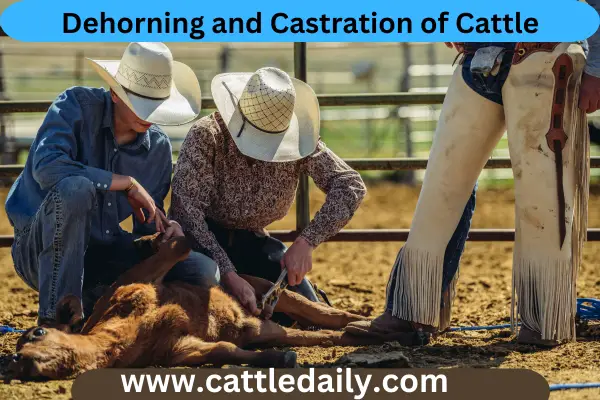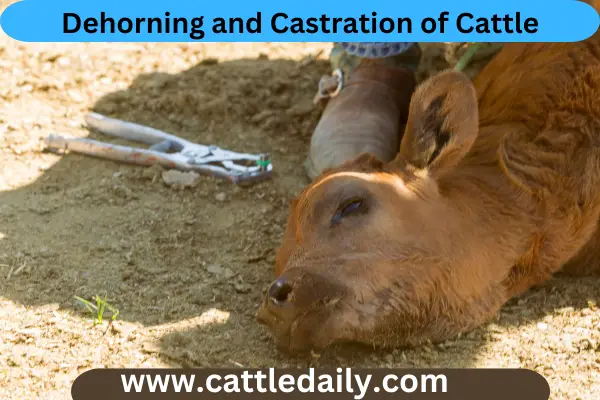Dehorning and Castration of Cattle
Dehorning and castration are two common procedures performed on cattle for health, safety, and productivity reasons. While some view these practices as inhumane, they are often necessary within the cattle industry.
When done properly and at the right age, dehorning and castration minimize pain and distress while providing benefits for both cattle and their caretakers. In this blog post, we will discuss in detail about Dehorning and Castration of Cattle.
What is dehorning?
Dehorning is the process of removing the horns of cattle. Horns are bony outgrowths that protrude from the heads of certain animals like cattle. The horn buds usually start developing in calves within 2-3 months of age. Dehorning is typically done early in an animal’s life before the horn buds attach to the skull.
Why Dehorn Cattle?
There are several reasons this procedure is performed:
- Horned cattle are dangerous to humans and other animals. Horns allow cattle to seriously injure each other and handlers. Dehorning reduces risks.
- Horns make handling and transporting cattle difficult. Dehorned cattle are easier to work with and less likely to become tangled in fences or equipment.
- Horns limit space at feeders and waterers. Cattle without horns can more easily access food and water resources.
- Dehorned steers grow faster and more efficient. The energy that would go into horn growth is instead used for body growth.
Proper Dehorning Techniques
To minimize pain and stress, dehorning should occur at a very young age before nerves and blood supply develop within the horn bud. Methods may include:
- Chemical disbudding with caustic paste to burn off small horn buds in calves under 3 weeks old. This causes little pain and heals quickly.
- Hot iron disbudding for horn buds under 2 months old. A hot electric dehorner applied to the bud destroys cells and stops horn growth.
- Barnes-type dehorning for older calves involves cutting horn tissue away from the skull and then using an electric dehorner to stop bleeding. This causes more pain and stress.
- Large horns in mature cattle require removal by a veterinarian under sedation or local anesthetic. This causes temporary pain but minimizes long-term discomfort.
- Saw amputation – Sawing off full-sized horns and stopping the bleeding.
- Tipping – Removing just the tips of large horns in older cattle.

Risks of dehorning
Risks include:
- Pain and stress during the procedure if no anesthesia is used
- Infection or uncontrolled bleeding if wound is not cauterized or treated
- Sinus complications if horn buds are attached to skull
- Regrowth of horn tissue if procedure is not done properly
Ethical considerations of dehorning
Ethical debates around dehorning include:
- Pain and stress caused to animals
- Loss of an innate physical characteristic important to social behavior
- Doing an elective procedure solely for human benefit versus medical necessity
Alternatives to dehorning
Alternatives include:
- Raising genetically polled or naturally hornless cattle breeds
- Letting horns grow but blunting tips to reduce harm
- Using horn protectors to cover tips
- Keeping calves with mothers instead of housing in groups
What is castration?
Castration is the process of removing the testicles of male cattle. This involves surgically removing the testes or using other techniques like banding to cut off blood flow to the scrotum.
Why Castrate Cattle?
This is usually done at a young age for these reasons:
- Intact males are aggressive and dangerous. Castration reduces aggression and violent behaviors.
- Bull meat has an undesirable taste compared to steers. Consumers prefer the flavor of beef from castrated males.
- Castrated steers fatten better on less feed compared to bulls. Steers are more efficient for beef production.
- Castration eliminates the risk of unwanted breeding in mixed cow and heifer herds.
Proper Castration Procedures
As with dehorning, castrating calves at the youngest age possible reduces pain and stress. Methods include:
- Rubber band castration in the first week of life causes little pain due to undeveloped nerves. Rubber bands cut off blood supply so testicles dry up and fall off.
- Surgical castration within the first month of life minimizes discomfort. A scalpel is used to remove testicles. Bleeding is stopped with emasculators.
- Older calves experience more pain when castrated. Castration combined with pain control is warranted for humane management.
- Burdizzo method – Crushing blood supply to the testes using a clamping instrument.
- Banding – Placing tight rubber bands around the base of the scrotum to cut off circulation.

Risks of castration
Risks of castration involve:
- Pain, stress and discomfort during and after procedure.
- Infection, swelling, prolonged bleeding of surgical wounds.
- Damage to penile tissue if performed incorrectly.
- Continued mating behavior if immature testicle cells remain.
Ethical considerations of castration
Ethical concerns regarding castration include:
- Pain and stress inflicted on animals.
- Altering natural hormones and behaviors of cattle.
- Performing medically unnecessary procedures primarily for profit and convenience.
Alternatives to castration
Alternatives to castrating cattle are:
- Using polled breeds that don’t grow horns.
- Keeping intact males separate from females when not breeding.
- Using pharmaceuticals to suppress testosterone and mating behaviors.
- Performing vasectomies to sterilize but not castrate males.
Conclusion
Dehorning and castration are very common practices in cattle management. Though controversial, many producers continue to use these procedures to improve herd safety, increase productivity, and provide end product quality desired by consumers.
However, when performed, both dehorning and castration should be done humanely at the earliest age possible to minimize risks and animal suffering. Learn here more about cattle farming tips and guides.
FAQs:
Q. Why should cattle be dehorned?
A. Cattle are dehorned primarily for safety – to prevent them from injuring each other or their handlers. Dehorning also makes cattle easier to manage and transport. It allows them to be confined in smaller spaces and prevents them from getting caught in equipment.
Q. What are the methods of dehorning cattle?
A. Common methods include chemical disbudding for young calves, hot iron disbudding for horn buds under 2 months, Barnes-type dehorning for older calves, saw amputation for mature cattle with full horns, and tipping for partial removal.
Q. At what age should calves be dehorned?
Dehorning should be done at the earliest age possible, ideally before 2 months old. This prevents the horn buds from attaching to the skull and minimizes pain and complications.
A. Is dehorning painful?
Dehorning at a very young age causes only minimal pain. However, the procedure can become increasingly painful the older the cattle get. Using anesthesia is recommended to reduce pain in older calves.
Q. What are the risks of dehorning?
Risks include pain, bleeding, infection, scurs or horn regrowth if the procedure is not done properly early on, and sinus complications if horn buds are removed after attaching to the skull.
Q. Why are some cattle castrated?
A. Male cattle are castrated to make them more docile, prevent unwanted breeding, improve meat quality, and increase weight gain on less feed. Steers (castrated males) are preferred for beef production.
Q. What techniques are used for castration?
A. Common techniques include surgical removal of testicles, banding, Burdizzo clamping, and chemical injection. The method depends on calf age and operator preference.
Q. At what age should cattle be castrated?
A. Castration is best performed at a very young age, typically under 1 month old. This helps minimize pain, stress, and complications.
Q. Is castration painful?
Castration causes varying degrees of pain depending on the method, age of the animal, and use of pain management. Using anesthesia provides more humane pain control.
Q. What are the risks of castration?
Risks include pain, swelling, bleeding, infection, damage to the penis if done improperly, and failure to completely neuter the animal. Pain control is recommended to reduce risks.


